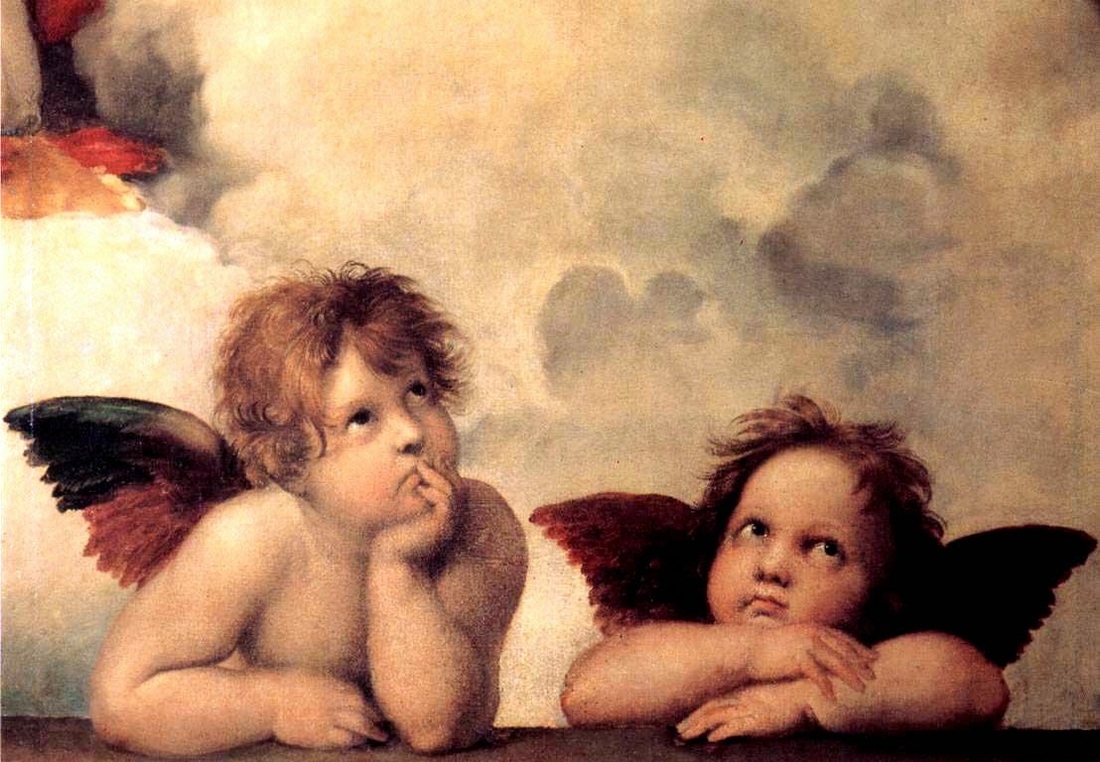|
This is the third post in a series. To start from the beginning, click here. William Hogarth's painting, A Scene from "The Tempest" (c. 1730), depicts the same moment in the play, but focuses attention on lines that happen just after, when Miranda sees Ferdinand for the first time and declares him, “A thing divine” (1.2.422), which not only draws attention to the human drama unfolding but also relies heavily on the religious undertones in the play. In the Hogarth image, Ariel appears like a cherub. Although Ariel’s fairy wings are visible, Hogarth is clearly drawing on religious iconography of childlike angels akin to Raphael’s cherubim in the Sistine Madonna. Ariel is also periphery to the action of Hogarth’s painting. Everyone in the painting looks at Miranda—the miraculous—whereas she looks intently on Ferdinand. The colors she wears and the iconography associated with her, such as a lamb, make her into a strangely Marian figure; the scene, therefore, approximates the Epiphany, which is fitting since Ferdinand is discovering this wonder for the first time. Hogarth’s reading of this scene highlights the religious language of the text, but it downplays a more sinister side to the scene. In Shakespeare’s play, Ariel not only draws Ferdinand toward him with the tempting “sweet air” (1.2.397) but also threatens him with horrifying taunts about his father’s seeming demise: “Full fathom five thy father lies; / Of his bones are coral made; / Those are pearls that were his eyes” (1.2.400-402). In contrast, Hogarth’s Ariel appears wholly unthreatening as a childlike angel, and a lone angel at that (unlike the Dadd painting, wherein we see a bacchanalian community of spirits). Hogarth thus presents a strangely anesthetized version of the moment in the play, and he renders Ariel into a nonthreatening character. His religious interpretation suppresses the subversive pagan dance that Dadd suggests.
0 Comments
This is the second post in a series. To start from the beginning, click here. For my visualizing assignment, the images fall into three groups based on the passages in the play that they illustrate. Richard Dadd's Come Unto These Yellow Sands (1842) and William Hogarth's A Scene from "The Tempest" (c. 1730) are both oil paintings that depict Ariel’s first song in the play. The Dadd painting above draws attention to its textual source in the title, which points students to the opening lines of Ariel’s song as he is leading Ferdinand to Miranda, “Come unto these yellow sands, / And then take hands; / Curtsied when you have and kissed— / The wild waves whist— / Foot it featly here and there; / And, sweet sprites, bear / the burden” (1.2.378-384). This painting is immediately striking because it imaginatively reinterprets the events of the play. In Shakespeare’s play we see Ariel alone on stage with Ferdinand, but we hear the other spirits “dispersedly” from several directions offstage (1.2.385 s.d.). Dadd draws our attention to the “sweet sprites” who “bear / the burden” or the refrain of a song. The words of the song seem to be about romantic love: taking hands, dancing, curtsying, and kissing. It is easy for students to see this song as simply anticipating the courtship that is about to happen between Miranda and Ferdinand. Dadd suggests the possibility of a fairy dance, so that in these lines the sweet sprites are taking hands and dancing with each other instead of Ariel directing Ferdinand to act a certain way with Miranda. In fact, Dadd seems to eliminate Ferdinand from the painting entirely. The poem places Ariel in a community, one that is governed over by a Fairy Queen (perhaps Ceres, since she appears to be flanked by a daughter) rather than by Prospero. In his interpretation of the play, Dadd edits out the humans and creates a world that is entirely fey. By displacing Prospero from the play’s power structure, Dadd creates a subversive reading of the play. In the next couple of blog posts, I want to discuss an assignment that I am developing for my AP Lit class for our discussion of Shakespeare's The Tempest. The format of a digital classroom has been a reminder for me about some of the core humanist principles that underlie the majority of our teaching practices. This series of posts will explore some of those principles in a writing assignment that I have used (and am still developing) for my students: a visual analysis of Shakespeare’s The Tempest. I am working with Kathleen Fitzpatrick’s definition of the field of the Digital Humanities: [A] nexus of fields within which scholars use computing technologies to investigate the kinds of questions that are traditional to the humanities, or, ask traditional kinds of humanities-oriented questions about computing technologies. This assignment uses digitized images to investigate a series of questions about Shakespeare’s play that are themselves quite traditional, but then the assignment provokes questions about how this technology changes the rhetorical power of images for students in their reading and writing. I ask my students to consider a selection of illustrations as “non-verbal” interpretations of Shakespeare’s play and I focus my attention on the character Ariel. I use an archive of images from Shakespeare Illustrated, a website maintained by Harry Rusche at Emory University. I ask students to explain the interpretation that the artist is making, and evaluate it based on textual evidence that they find in Shakespeare. This exercise was inspired by Virginia’s Tufte’s essay, “Visualizing Paradise Lost: Classroom Use of Illustrations by Medina, Blake, and Doré,” from which I draw heavily. She argues, and I agree, that asking students to consider illustrations as a type of interpretation of the text encourages students to return to the text in order to close read passages. The list of questions that I include below comes from her essay, but is adapted to Shakespeare’s play instead of Milton’s epic:
|
Claire Dawkins
English Instructor at Stanford's Online High School Archives
August 2015
Categories
All
|





 RSS Feed
RSS Feed